Humayun driven out of Delhi by
the Afghan Sher Shah Sun i in 1540, spent fifteen years in exile in Persia and Afghanistan. Shah
Tahmasp of Persia gave him shelter and also promised military aid for recovery
of his kingdom. During his exile Humayun spent some months at Tabriz and
Kazwin. At the court of Shah Tahmasp at Tabriz he saw the paintings of the
Persian artists Aga Mirak, Sultan Muhammad and Muzaffar Ali, pupils of the
famous Bihzad. Later he met the painter Mir "Sayyid Ali, the illustrator
of Nizami's Khamsdh. Thus he acquired taste for paintings and became a
connoisseur of art. At his request Mir Sayyid Ali Tabrizi and Abdus Samad
Shirazi joined him at Kabul in 1549. Abdus Samad was also a calligrapher. They
gave lessons in painting to Humayun and his son Akbar. When Humayun regained
his throne, both the artists accompanied him to India.
The birth of Mughal painting in
India is due to the patronage of Akbar (1556-1605). He collected architects,
painters and calligraphers at his new city of Fatehpur-Silcri. More than a
hundred painters, both Hindus and Moslems, mostly from Kashmir, Punjab,
Gwalior, Rajasthan and Gujarat worked under the Persian master artists, Abdus
Samad and Mir Sayyid Ali. Inspired by Akbar, a cultural synthesis was promoted
and the result was a new school of painting which is Indian in spirit and
Persian in technique. Baber himself was a Barlas Turk and not a Mongol.,
However, his dynasty acquired the name of Mughal, and the paintings of the new
school are called Mughal Painting. The term 'miniatures of the Baburid period'
suggested by Hamid Suleiman is cumbrous, and is no improvement on the accepted
term, which by common usage is now accepted by all scholars.
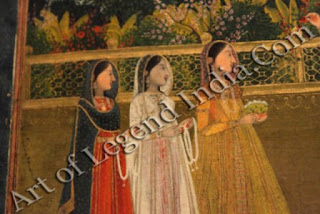 Akbar was very fond of the
adventures of Harnza. Mir Hamza was the uncle of the Pro-phet, and his
adventures are narrated in the book named after him. Mir Sayyid Ali painted
anecdotes from the Hamzd Namd. These are large size paintings on cloth, in
Persian Safavi style. Brilliant red, blue and green colours predominate in
these paintings and blossoming plums and peaches and amber foliage of planes
remind us of Persia.
Akbar was very fond of the
adventures of Harnza. Mir Hamza was the uncle of the Pro-phet, and his
adventures are narrated in the book named after him. Mir Sayyid Ali painted
anecdotes from the Hamzd Namd. These are large size paintings on cloth, in
Persian Safavi style. Brilliant red, blue and green colours predominate in
these paintings and blossoming plums and peaches and amber foliage of planes
remind us of Persia.
It seems that stimulus for
painting was provided by the illiteracy of Akbar. As he was unable to read, he
felt the need of paintings as a visual aid. He was a broad-minded monarch who
respected all religions. Anecdotes from the Hindu classics, the Ramayana, and
the Mahabharata which were venerated by his Hindu subjects were painted by his
artists. He was proud of his ancestry and wanted to visualize the exploits of
his ancestors Timur and Babur as well as his own victories and achievements.
This led to the painting projects like the Timur Nama, the Babur Nama and the
Akbar Nama, all based on Persian texts.
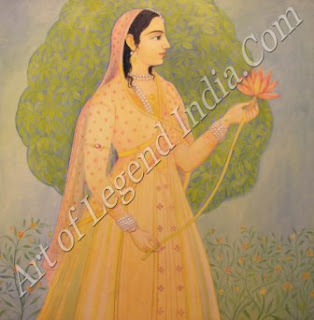 An illustrated manuscript copy
of the Akbar Nama is in the collection of the Victoria and Albert Museum,
London. It was prepared for the library of Akbar. It bears the signatures of
Jahangir, and a seal of Aurangzeb. During the decline of the Mughal Empire the
books in the royal library got dispersed, and the Akbar Nama fell into the
hands of one Ahmad Ali Khan in 1793. It was purchased by Major General John
Clark, the Commissioner of Oudh in 1896. It was acquired by the Victoria and
Albert Museum from his widow. This manuscript contains 274 folios and 117
paintings. It was illustrated by fifty six artists whose names arranged
alphabetically are given below:
An illustrated manuscript copy
of the Akbar Nama is in the collection of the Victoria and Albert Museum,
London. It was prepared for the library of Akbar. It bears the signatures of
Jahangir, and a seal of Aurangzeb. During the decline of the Mughal Empire the
books in the royal library got dispersed, and the Akbar Nama fell into the
hands of one Ahmad Ali Khan in 1793. It was purchased by Major General John
Clark, the Commissioner of Oudh in 1896. It was acquired by the Victoria and
Albert Museum from his widow. This manuscript contains 274 folios and 117
paintings. It was illustrated by fifty six artists whose names arranged
alphabetically are given below:
Anant,
Asi brother of Miskina, Babu Naqqash, Bandi, Banwali Kalan, Banwali Khurd,
Basawan, Bhawani, Bhawani Kalan, Bhagwan, Bhura, Chitr Muni, Durga, Dharm Das,
Dhanwan, Farrukh Beg, Husain Naqqa'sh, Ikhlas, Ibrahim Kahar, Jagan, Jagjiwan,
Kaheman Sangtrash, Khem Karan, Kesu, Kesu Kalan, Kesu Khurd, Kanha, La!, Madhu
Kalan, Mukund, Miskin, Mahesh, Madhu Khurd, Mansur, MO Muhammad, Manohar,
Narayan, Nand or Nandi, son of Ram Das, Naman, Narsingh, Nanha, Nand Gwaliori,
Paras, Param jeo Gujrati, Qutub Chela, Ram Das, Sanwala, Sarwan, Stir DAs,
Shankar, Tulsi, Tulsi Kalan, Tiriya and Tara.
According to Ahmad Nabi Khan,
who studied the Akbar Nama, it was a co-operative work, in which the work of
drawing the outline was executed by distinguished artists, while portraiture
was entrusted to some, and colouring to minor ones. Among the leading artists
who drew the outlines are Basawan, Jagan, Kesu Kalan, Lal, Miskin, Tulsi Kalan,
and a few others.
There are four illustrated
manuscripts of the Baur Nama which are worthy of notice. Of these one is
preserved in the British Museum (Or. 3714). It was gifted to the museum by G.
G. Barnard on June 1, 1889. It has 529 folios out of which 118 are painted.
This is the work of forty one artists. This illustrated manuscript has been
recently studied by Hamid Suleiman and published by the Academy of Science of
the Uzbek Soviet Socialist Republic. In this book 92 illustrations have been
reproduced in colour. In this Babur Nama garden scene are excellent. The names
of artists are as below:
 Abdullah,
Banwari Khurd, Banwari Kalan, Bhura, Bhawani, Dhannu, Dev Gujarati, Dhan Raj,
Farrukh, Gobind, Jamshed, Jagnath, Khusro Quli, Khizr Khela, Ibrahim Kahar,
Ibrahim Naqash, Khem, Kesu Gujarati, Mansur, Manohar, Mukesh, Mukhlas, Nand
Gwaliori, Nama, Padarath, Prem Gujarati, Ram Das, Rasika, Ras, Shankar Gujrati,
Shiv DAs, Sanwala, Sarwan, Shyam, Surjan, Stir Ds, Sur Gujarati, Triya, Talok,
Tulsi Khurd and Tharial.
Abdullah,
Banwari Khurd, Banwari Kalan, Bhura, Bhawani, Dhannu, Dev Gujarati, Dhan Raj,
Farrukh, Gobind, Jamshed, Jagnath, Khusro Quli, Khizr Khela, Ibrahim Kahar,
Ibrahim Naqash, Khem, Kesu Gujarati, Mansur, Manohar, Mukesh, Mukhlas, Nand
Gwaliori, Nama, Padarath, Prem Gujarati, Ram Das, Rasika, Ras, Shankar Gujrati,
Shiv DAs, Sanwala, Sarwan, Shyam, Surjan, Stir Ds, Sur Gujarati, Triya, Talok,
Tulsi Khurd and Tharial.
There is another illustrated
manuscript of the Babur Nama in the State Museum of Eastern Cultures, Moscow,
which has been studied by Tulayev, who reproduced 22 paintings from it in
monochrome. It has 69 miniature paintings on 57 folios. It was originally
presented to the Russian Ambassador Prince Dolgorukov by the mother of
Nasaruddin, Shah of Persia. Stchoukine, the Russian collector of Oriental art
received it as a gift from one Alexei Morozov. The Stchoukine collection
ultimately came to the State Museum of Eastern Culture, Moscow. Its folios do
not have the names of any artists. Its paintings, however, do not resemble
those of the British Museum or the National Museum, Babur Nama. They are,
however, of good quality and worthy of reproduction in colour.
The Victoria and Albert Museum,
London, has 18 paintings of the Babur Nama. Out of these two show plants, birds
and animals, seven battle scenes, and twelve various anecdotes like feasts and
harem scenes, and one an ashram of Sadhus. Their style is different from that
of other Babur Natneis, and Babur is depicted wearing a plumed helmet. A battle
scene bears the names of artists Lal and Durga (tareih Lãl, amal Durga) and
another of Mukand and Kheman (tiara Mukand, amal Kheman Sangtreish). A painting
showing a camel and elephant fight bears the name of Chela, and another showing
presentation of tribute has the name Yakub Kashmiri niimi Lal inscribed on it.
The quality of paintings is poor as compared with the other Baur Nameis.
The Babur Nama of the National
Museum (N. M. 50.326), New Delhi, which is the subject of this monograph has
378 folios. Out of these 122 folios are illustrated with 144 illustrations.
Forty two illustrations depict flora and fauna, twenty seven historial
episodes, twenty seven personal life of Babur, twenty five battle scenes,
twelve domestic life, seven hunting scenes, and three show feasts. It was
acquired by the National Museum from Agra College, Agra. The illustrated folios
bear the names of forty nine artists, neatly written by the calligrapher. These
are given below in alphabetical order:
Allah
Quli, Anant, Asi, Asi Kahar, Bandi, Banwari Khurd, Bhag, Bhagwan, Bhawani,
Bhura, Daulat, Dhannu, Dhan Raj, Dhaxm Das, Farrukh Chela, Fattu, Gobind,
Husain Cheld, Ibrahim, Ibrahim Kahar, Jagnath, Jamal, Jamshed, Kesu Kahar,
Khem, Khem Karan, Khizra, Lachhman, Lohka, Madho, Mahesh, Makra, Mansur,
Miskin, Mohammad Kashmiri, Mohammad Pandit, Naman, Nand Gwaliori, Naqi, Narsi,
Narsingh, Prem, Prem Gujrati, Sarwan, Shankar, Shiv Das, Sur Das, Timur (Ustad)
and Tulsi.
Of these artists Mansur was the
same who later on painted birds and animals for Jahangir. Daulat was an artist
of high merit. The same may be said of Sur Das, Bhura, Jagnath, Dharm Das, Asi,
Nand Gwaliori and Makra.
 A comparison of the names of
artists of the National Museum Babur Nama, British Museum Babur Nama, and Akbar
Nama of the Victoria and Albert Museum reveals interesting facts. The Akbar
Mimi' was painted by fifty three artists and the National Museum Babur Nama by
forty nine artists. The following twenty artists are common to both these
illustrated manuscripts.
A comparison of the names of
artists of the National Museum Babur Nama, British Museum Babur Nama, and Akbar
Nama of the Victoria and Albert Museum reveals interesting facts. The Akbar
Mimi' was painted by fifty three artists and the National Museum Babur Nama by
forty nine artists. The following twenty artists are common to both these
illustrated manuscripts.
Anant,
As!, Band!, Banwari Khurd, Bliagwan, Bhawani, BhUra, Dharam DAs, Ibrahim Kahar,
Madhti, Mahesh, Mansur, Miskin, Nama, Nand Gwaliori, Narsingh, Param Jeo
Gujrati, Sarwan, Shankar, Sur Das and Tulsi.
The following twenty artists
are common to the Babur Namas of the British Museum and the National Museum,
New Delhi.
Banwari
Khurd, Shard, Bhawani, Dhan Raj, Farrukh Beg, Gobind, Ibrahim Kahar, Jagnath,
Jamshed Chela, Khem, Khizr Chela, Mahesh, Mansur, Nand Gwaliori, Nama, Shankar,
Shiv Das, Sarwan, Stir and Tulsi.
The following ten artists are
common to the Victoria and Albert Akbar Noma and the National Museum Baur Namd,
viz. Asi, Banwari Khurd, Bhawani, Ibrahim Kahar, Mahesh, Mansur, Nama, Nand
Gwaliori, Sur Das, and Tulsi.
There is no doubt that Victoria
and Albert Akbar Nama- belongs to the royal library of Akbar. The presence of
the signatures of Jahangir and seal of Aurangzeb on the binding confirm it. The
analysis which I have given above also leads to the conclusion that the British
Museum Babur Mind and the National Museum Babur Nama also came from the same
source. The high quality of paintings of both these manuscripts further lends
support to this conclusion. The same, however, cannot be said of Moscow and
Victoria and Albert manuscripts. They were painted by different artists.
Rai Krishnadasa was the first
scholar who studied the National Museum's Babur Mind in 1955, and also
reproduced two paintings in colours in his Mughal Miniatures. Commenting on the
Baur Noma he wrote as follows:
"The copy from which the
two illustrations are reproduced is in the National Museum, New Delhi, and is
the fifth important copy of the Babar Nama known to students of Mughal
painting. This copy belonged to the Imperial Library as is attested by the
signature of Shah khan and the names of the royal artists inscribed on the
paintings. It is well known that Shah Jahan was in the habit of signing
manuscripts in the Imperial Library. The date of the MSS can fortunately be
ascertained. Folio 116 illustrating the twenty-fourth picture by Khem bears an
inscription which states it was painted in the 42nd regnal year of Akbar, i.e.
1598 A.D."
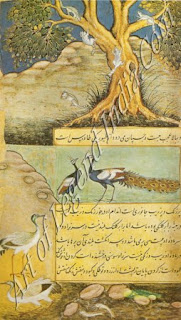 Basil Gray was the next scholar
who noticed this Babur Nama. He observed as follows: "Two other copies of
the Babur Nama have survived from approximately this period. One, now in the
National Museum of India, but formerly in Agra College is actually dated on one
miniature 1597."
Basil Gray was the next scholar
who noticed this Babur Nama. He observed as follows: "Two other copies of
the Babur Nama have survived from approximately this period. One, now in the
National Museum of India, but formerly in Agra College is actually dated on one
miniature 1597."
Careful examination of folio
116, a painting by Khem, shows the date, which has been partially mutilated in
the process of binding. It is Ilahi '42', which is Akbar's era and gives an
A.D. equivalent of 1598.
The illustrated Babur Namas are
based on Persian translation of the Baur Nãmã in Turki. The translation in
Persian was finished by Khan Khanan Abdul Rahim in 1589. It seems all these
Babur Namas were illustrated between 1595 and 1605 during the life-time of
Akbar.
A remarkable character of the Babur
Nama paintings of the four series is their originality. As Barrett and Gray
remark, 'there is little repetition in these several series and so much
invention.'
The portraiture of the face of
Wilbur is uniform throughout the series. It is likely that it is the work of
one artist. It is possibly based on a portrait of Babur, which must have been
painted during his life-time. He has the eyes of a dreamer, an aquiline nose
and a pointed beard. The poet and man of action, Babur, are well portrayed.
 Faces of men and women are
usually shown three quarter or in profile.
Faces of men and women are
usually shown three quarter or in profile.
Even when the artists are
painting scenes from Farghana and Kabul, they depict the architecture of India.
In the landscapes on the top of some paintings, palms and plantains of India
are painted. Among the birds in these landscapes are moon-partridges and
peacocks, which are admired by the poets of India. In the foreground of some of
the paintings of birds and plants, lotuses with their leaves topsy-turvy and
ducks playing among them are painted (Folio 277). These symbols of love
acquired a poetic significance as in due course the Mughal painting evolved
into Kangra style.
The treatment of mountains is
characteristic of Mughal painting of the Akbar period. It is a direct borrowing
from Persian painting. Rocks piled upon each other are more seen in arid Persia
than in India.
The Babur Nama is also an
illustrated social history of India. Soldiers and horses were clad in armour.
Battles were fought with swords, bows and arrows. Drums were lustily beaten to
infuse courage among the soldiers. We also see the first use of artillery.
Rivers were crossed on bridges of boats and rafts. Camels and bullocks were
commonly used for transport of goods. The dress of nobles was elaborate. In
this Babur Nama we see the first record of a wooden Persian wheel with
terracotta buckets (Folio 121) and of a hand-mill (Folio 70). The rulers were
approached with respect and many paintings give us a glimpse of court etiquette
and ceremonial. Some of the paintings are very expressive. We perceive
adulation on the faces of the courtiers and determination and courage on the
faces of soldiers. The figures are shown in movement, and their highly
expressive gestures convey their feelings.
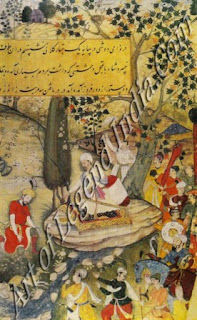 The section of the Babur Nama
which deals with India is the first illustrated Natural History of India. Babur
came from Central Asia and Afghanistan, which do not have that variety in fauna
and flora as India. A keen observer and lover of nature who delighted in plants
and gardens, he was amazed by what he saw in India. He is the first person to
record the birds, beasts and plants of India. His description of plants, birds
and animals are brief but pertinent. He could distinguish the different
varieties of oranges in India. He saw the wild plantains, which can be seen
even now near Mandu. Among the birds he noted peacocks, monal pheasants,
herons, hoopoes, green pigeons, parrots, ducks, pelicans and storks of many
varieties. Among the animals he mentions antelopes, thars, onagers, black buck,
wolves, foxes, rhinoceros and nilgais. He noticed the affinity between the
squirrel and mouse, which are both rodents. He also noticed the kinship between
the rhinoceros and the horse, which are Peris-sodactyls. However, he mistook
the flying fox as a bird. Considering the age in which he lived, he can rightly
claim to be the first natural history scientist of India. His genes for love of
plants and animals were inherited by his great grandson Jahangir, who was also
a keen observer. Jahangir's favourite artist was Mansur, some of whose early
paintings are seen in this Babur Nama.
The section of the Babur Nama
which deals with India is the first illustrated Natural History of India. Babur
came from Central Asia and Afghanistan, which do not have that variety in fauna
and flora as India. A keen observer and lover of nature who delighted in plants
and gardens, he was amazed by what he saw in India. He is the first person to
record the birds, beasts and plants of India. His description of plants, birds
and animals are brief but pertinent. He could distinguish the different
varieties of oranges in India. He saw the wild plantains, which can be seen
even now near Mandu. Among the birds he noted peacocks, monal pheasants,
herons, hoopoes, green pigeons, parrots, ducks, pelicans and storks of many
varieties. Among the animals he mentions antelopes, thars, onagers, black buck,
wolves, foxes, rhinoceros and nilgais. He noticed the affinity between the
squirrel and mouse, which are both rodents. He also noticed the kinship between
the rhinoceros and the horse, which are Peris-sodactyls. However, he mistook
the flying fox as a bird. Considering the age in which he lived, he can rightly
claim to be the first natural history scientist of India. His genes for love of
plants and animals were inherited by his great grandson Jahangir, who was also
a keen observer. Jahangir's favourite artist was Mansur, some of whose early
paintings are seen in this Babur Nama.
Writer
– M.S. Randawa
 Akbar was very fond of the
adventures of Harnza. Mir Hamza was the uncle of the Pro-phet, and his
adventures are narrated in the book named after him. Mir Sayyid Ali painted
anecdotes from the Hamzd Namd. These are large size paintings on cloth, in
Persian Safavi style. Brilliant red, blue and green colours predominate in
these paintings and blossoming plums and peaches and amber foliage of planes
remind us of Persia.
Akbar was very fond of the
adventures of Harnza. Mir Hamza was the uncle of the Pro-phet, and his
adventures are narrated in the book named after him. Mir Sayyid Ali painted
anecdotes from the Hamzd Namd. These are large size paintings on cloth, in
Persian Safavi style. Brilliant red, blue and green colours predominate in
these paintings and blossoming plums and peaches and amber foliage of planes
remind us of Persia.  An illustrated manuscript copy
of the Akbar Nama is in the collection of the Victoria and Albert Museum,
London. It was prepared for the library of Akbar. It bears the signatures of
Jahangir, and a seal of Aurangzeb. During the decline of the Mughal Empire the
books in the royal library got dispersed, and the Akbar Nama fell into the
hands of one Ahmad Ali Khan in 1793. It was purchased by Major General John
Clark, the Commissioner of Oudh in 1896. It was acquired by the Victoria and
Albert Museum from his widow. This manuscript contains 274 folios and 117
paintings. It was illustrated by fifty six artists whose names arranged
alphabetically are given below:
An illustrated manuscript copy
of the Akbar Nama is in the collection of the Victoria and Albert Museum,
London. It was prepared for the library of Akbar. It bears the signatures of
Jahangir, and a seal of Aurangzeb. During the decline of the Mughal Empire the
books in the royal library got dispersed, and the Akbar Nama fell into the
hands of one Ahmad Ali Khan in 1793. It was purchased by Major General John
Clark, the Commissioner of Oudh in 1896. It was acquired by the Victoria and
Albert Museum from his widow. This manuscript contains 274 folios and 117
paintings. It was illustrated by fifty six artists whose names arranged
alphabetically are given below:  Abdullah,
Banwari Khurd, Banwari Kalan, Bhura, Bhawani, Dhannu, Dev Gujarati, Dhan Raj,
Farrukh, Gobind, Jamshed, Jagnath, Khusro Quli, Khizr Khela, Ibrahim Kahar,
Ibrahim Naqash, Khem, Kesu Gujarati, Mansur, Manohar, Mukesh, Mukhlas, Nand
Gwaliori, Nama, Padarath, Prem Gujarati, Ram Das, Rasika, Ras, Shankar Gujrati,
Shiv DAs, Sanwala, Sarwan, Shyam, Surjan, Stir Ds, Sur Gujarati, Triya, Talok,
Tulsi Khurd and Tharial.
Abdullah,
Banwari Khurd, Banwari Kalan, Bhura, Bhawani, Dhannu, Dev Gujarati, Dhan Raj,
Farrukh, Gobind, Jamshed, Jagnath, Khusro Quli, Khizr Khela, Ibrahim Kahar,
Ibrahim Naqash, Khem, Kesu Gujarati, Mansur, Manohar, Mukesh, Mukhlas, Nand
Gwaliori, Nama, Padarath, Prem Gujarati, Ram Das, Rasika, Ras, Shankar Gujrati,
Shiv DAs, Sanwala, Sarwan, Shyam, Surjan, Stir Ds, Sur Gujarati, Triya, Talok,
Tulsi Khurd and Tharial. A comparison of the names of
artists of the National Museum Babur Nama, British Museum Babur Nama, and Akbar
Nama of the Victoria and Albert Museum reveals interesting facts. The Akbar
Mimi' was painted by fifty three artists and the National Museum Babur Nama by
forty nine artists. The following twenty artists are common to both these
illustrated manuscripts.
A comparison of the names of
artists of the National Museum Babur Nama, British Museum Babur Nama, and Akbar
Nama of the Victoria and Albert Museum reveals interesting facts. The Akbar
Mimi' was painted by fifty three artists and the National Museum Babur Nama by
forty nine artists. The following twenty artists are common to both these
illustrated manuscripts.  Basil Gray was the next scholar
who noticed this Babur Nama. He observed as follows: "Two other copies of
the Babur Nama have survived from approximately this period. One, now in the
National Museum of India, but formerly in Agra College is actually dated on one
miniature 1597."
Basil Gray was the next scholar
who noticed this Babur Nama. He observed as follows: "Two other copies of
the Babur Nama have survived from approximately this period. One, now in the
National Museum of India, but formerly in Agra College is actually dated on one
miniature 1597." The section of the Babur Nama
which deals with India is the first illustrated Natural History of India. Babur
came from Central Asia and Afghanistan, which do not have that variety in fauna
and flora as India. A keen observer and lover of nature who delighted in plants
and gardens, he was amazed by what he saw in India. He is the first person to
record the birds, beasts and plants of India. His description of plants, birds
and animals are brief but pertinent. He could distinguish the different
varieties of oranges in India. He saw the wild plantains, which can be seen
even now near Mandu. Among the birds he noted peacocks, monal pheasants,
herons, hoopoes, green pigeons, parrots, ducks, pelicans and storks of many
varieties. Among the animals he mentions antelopes, thars, onagers, black buck,
wolves, foxes, rhinoceros and nilgais. He noticed the affinity between the
squirrel and mouse, which are both rodents. He also noticed the kinship between
the rhinoceros and the horse, which are Peris-sodactyls. However, he mistook
the flying fox as a bird. Considering the age in which he lived, he can rightly
claim to be the first natural history scientist of India. His genes for love of
plants and animals were inherited by his great grandson Jahangir, who was also
a keen observer. Jahangir's favourite artist was Mansur, some of whose early
paintings are seen in this Babur Nama.
The section of the Babur Nama
which deals with India is the first illustrated Natural History of India. Babur
came from Central Asia and Afghanistan, which do not have that variety in fauna
and flora as India. A keen observer and lover of nature who delighted in plants
and gardens, he was amazed by what he saw in India. He is the first person to
record the birds, beasts and plants of India. His description of plants, birds
and animals are brief but pertinent. He could distinguish the different
varieties of oranges in India. He saw the wild plantains, which can be seen
even now near Mandu. Among the birds he noted peacocks, monal pheasants,
herons, hoopoes, green pigeons, parrots, ducks, pelicans and storks of many
varieties. Among the animals he mentions antelopes, thars, onagers, black buck,
wolves, foxes, rhinoceros and nilgais. He noticed the affinity between the
squirrel and mouse, which are both rodents. He also noticed the kinship between
the rhinoceros and the horse, which are Peris-sodactyls. However, he mistook
the flying fox as a bird. Considering the age in which he lived, he can rightly
claim to be the first natural history scientist of India. His genes for love of
plants and animals were inherited by his great grandson Jahangir, who was also
a keen observer. Jahangir's favourite artist was Mansur, some of whose early
paintings are seen in this Babur Nama.
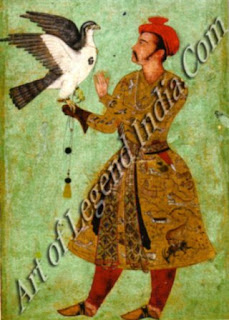













0 Response to "Painting of the Babur Nama "
Post a Comment